Flatters and Set Hammers: Understanding their Purpose in Blacksmithing
Abana Chapter
February 11, 2024

Diving into the world of blacksmithing opens up a vista of tools and techniques, none more central than the use of flatters and set hammers. These tools are the unsung heroes behind the shaping and finishing of metalwork, providing both novices and seasoned smiths with the means to achieve precision and finesse in their projects. Understanding the purpose and application of flatters and set hammers in blacksmithing is essential for anyone looking to delve deeper into this ancient craft, whether for hobbyist projects or professional endeavors.
Key Takeaways
Flatters and set hammers play a crucial role in blacksmithing for shaping and finishing metalwork, catering to both beginners and experienced craftsmen.
Flatter hammers are indispensable for creating smooth, flat surfaces on metal, an essential aspect of the blacksmithing process.
Set hammers are designed for precision work, allowing blacksmiths to focus on detailed shaping and finishing in their metalwork projects.
Selecting the appropriate hammer for a specific blacksmithing project is vital for achieving the desired results and efficiency in the craft.
The evolution and history of flatters and set hammers underscore their enduring importance in blacksmithing, reflecting advancements and changing practices in the field.
Mastery of essential blacksmithing techniques using flatters and set hammers is fundamental for anyone serious about excelling in metalworking crafts.
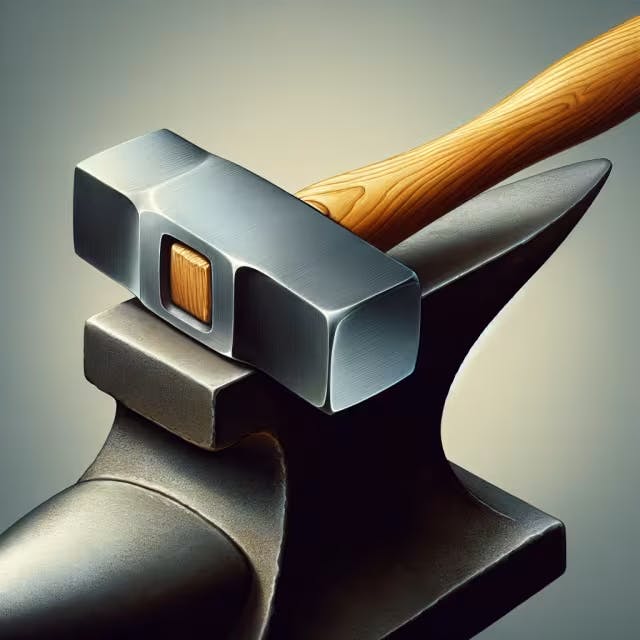
The Fundamental Role of Flatter Hammers in Blacksmithing
In the world of blacksmithing, precision and tool mastery define the fine line between a novice and an artisan. Among the essential tools that facilitate this craftsmanship are flatters and set hammers, each serving a specific purpose to shape metal with precision and finesse.
Flatters, typically made from high-grade steel, are used for smoothing and flattening large surfaces of metal. They are particularly useful after forging, to remove any marks left by other tools, ensuring a clean and even surface. Their design consists of a flat face which, when struck by a sledgehammer, applies uniform pressure across the metal's surface.
Set hammers, on the other hand, are more about detail and less about broad strokes. These tools have a narrower face compared to flatters and are utilized for defining sharp edges, corners, and for setting metal into specific shapes. They allow blacksmiths to work with precision on smaller sections of metal without affecting the entire piece.
Here's a quick comparison to illustrate their distinct roles:
Tool Type | Purpose | Best Used For |
Flatter Hammer | Smoothing and flattening surfaces | Large, flat metal surfaces |
Set Hammer | Detailing and shaping | Edges, corners, and specific shapes |
Understanding when and how to use these tools correctly can significantly impact the quality of the final product. Whether it’s a decorative piece or functional hardware, mastery over flatters and set hammers is essential for any aspiring blacksmith. Their application not only speaks to the skill of the blacksmith but also to the tradition and innovation within the craft itself. For more insights into blacksmithing tools and techniques, exploring online resources like Anvilfire can be incredibly beneficial for both beginners and seasoned professionals.
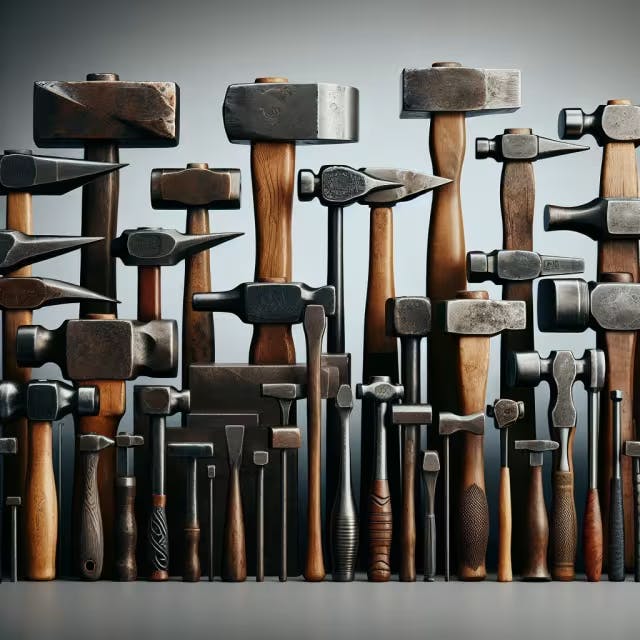
Set Hammers Explained: Precision Work in the Forge
Set hammers are specialized tools in the realm of blacksmithing, designed for precision tasks that require more control than what general forging hammers offer. They are used to refine the shape of metal, set in details, and finish surfaces without introducing new distortions. Unlike flatters, which spread metal evenly, set hammers focus on specific areas, allowing blacksmiths to achieve intricate designs and perfect fitting components essential for complex constructions.
Targeted Impact: Perfect for working on smaller, more detailed sections of metal.
Precision Forging: Enhances control over metal shaping, crucial for fine detailing.
Discover more about the fascinating world of forging and its tools by checking out this detailed exploration.
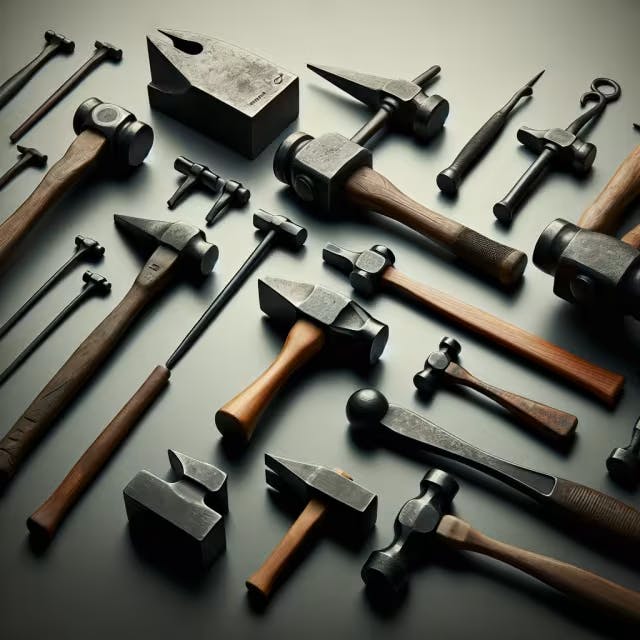
Choosing the Right Hammer for Your Blacksmithing Project
In the world of blacksmithing, knowing the specific tools for the job is crucial for both the quality of the work and the efficiency of the process. When it comes to finishing surfaces and shaping metals, flatters and set hammers are indispensable. Each serves a unique purpose, making it important to choose the right one based on the needs of your project.
Flatters are large, flat-faced hammers typically used to smooth out the surfaces of a metal piece. They're ideal for achieving a fine finish, especially after forging. Their flat surface evenly distributes force, minimizing marks on the metal.
Set Hammers, on the other hand, have a narrower face compared to flatters. They're primarily used for bending and shaping, allowing for more precision, especially in tight areas or for detailed work.
Selecting between a flatter and a set hammer depends on the specific requirements of your blacksmithing project. If your goal is to refine and smooth the surface of a workpiece, a flatter is your go-to tool. For projects that involve detailed shaping or working in confined spaces, a set hammer will serve you better.
For further clarity and to ensure you make the right choice for your needs, here's a quick comparison:
Hammer Type | Best For | Features |
Flatter | Smoothing surfaces | Large, flat face; Evenly distributes force |
Set Hammer | Detailed shaping/bending | Narrower face; Allows for precision |
Understanding the nuances of these tools can significantly impact the outcome of your blacksmithing project. By choosing the right hammer, you not only improve the quality of your work but also enhance your efficiency and effectiveness in the forge. For those looking to dive deeper into the realms of blacksmithing and tool selection, resources like Centaur Forge offer a wealth of information and a broad selection of tools tailored to the needs of modern blacksmiths.
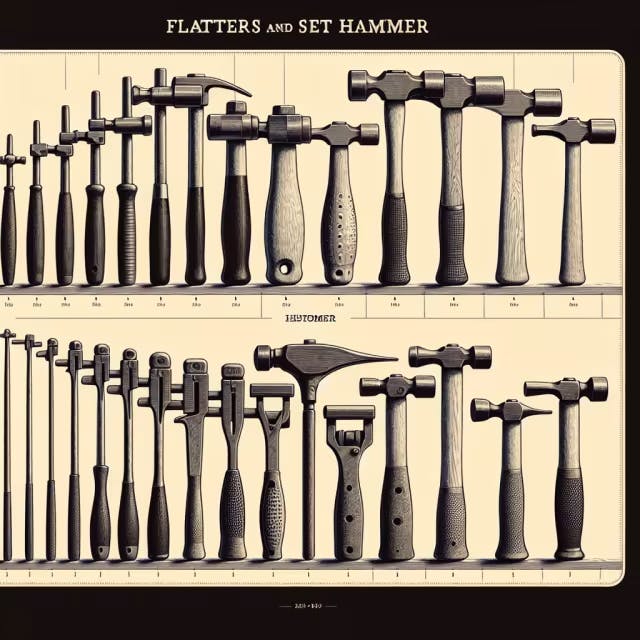
The Evolution and History of Flatters and Set Hammers
Flatters and set hammers have a storied history in the traditional craft of blacksmithing, serving as essential tools for metalworking. Originating from ancient times, these tools have been pivotal for blacksmiths in shaping and finishing metal workpieces with precision and efficiency.
Flatters: These are large, flat-faced hammers typically used to smooth the surfaces of metal. The purpose of a flatter is to refine the finish of a workpiece, removing marks left by other forging tools. It's applied with force directly on the hot metal, usually over an anvil, to achieve a smooth, flat surface.
Set Hammers: Unlike flatters, set hammers have a more specific role. They feature a square or rectangular face and are used for setting or moving metal in a controlled manner. When working in tight corners or detailed areas where precision is key, set hammers allow blacksmiths to direct the metal more accurately.
The evolution of these tools over centuries reflects advancements in metalworking techniques and materials. Initially, these hammers were made from basic materials available at the time, but as technology progressed, so did the quality and durability of the tools. Today, flatters and set hammers are made with high-grade steel and designed for ergonomic efficiency, enabling blacksmiths to work longer with less fatigue.
Their relevance in modern blacksmithing cannot be overstated. Despite the advent of power hammers and other advanced machinery, the nuanced control and finishing provided by flatters and set hammers remain unmatched for certain tasks. Their continued use speaks to the blend of traditional techniques with modern practices in contemporary metalworking.
For enthusiasts interested in exploring the world of blacksmithing, understanding the purpose and proper use of these tools is a foundational step. Whether used for artistic endeavors or practical applications, the knowledge and skills associated with flatters and set hammers are invaluable.
For further exploration into blacksmithing tools and techniques, including the use of flatters and set hammers, this comprehensive guide is a great resource: Explore Blacksmithing Techniques.
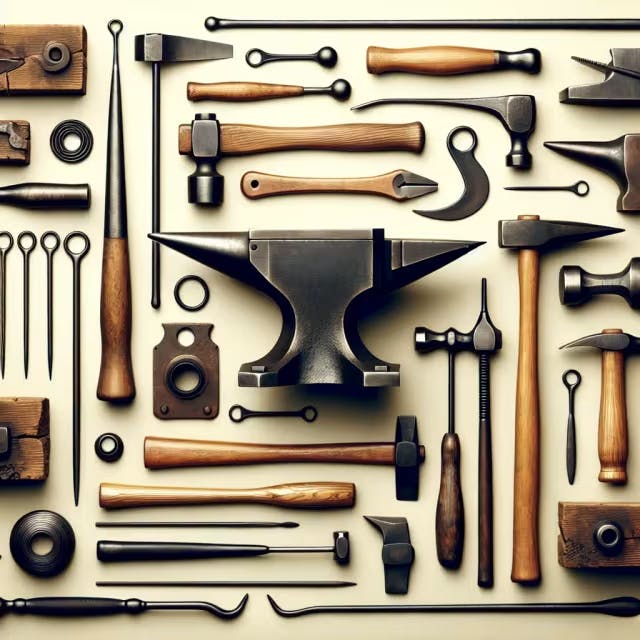
Essential Blacksmithing Techniques Using Flatters and Set Hammers
In the fascinating world of blacksmithing, mastering the use of specific tools can highly impact the quality and efficiency of your work. Among these tools, flatters and set hammers hold a pivotal role in shaping and finishing metal pieces. Here's a quick guide to understanding their purpose and how they can enhance your blacksmithing projects.
Flatters are usually large, flat-faced hammers that serve the purpose of smoothing and finishing surfaces. Their broad face makes them ideal for evening out the textures on a workpiece, ensuring that the final product has a professional appearance.
Set Hammers, on the other hand, have a more narrow face compared to flatters. They are primarily used for creating sharp bends and set downs in metal. This tool allows blacksmiths to work with precision on smaller areas without affecting the surrounding metal.
For beginners and experts alike, incorporating these tools into your work can make a significant difference in the outcome of your projects. Not only do they help in achieving the desired shapes and textures, but they also contribute to the overall structural integrity of the metal pieces. By using flatters and set hammers appropriately, blacksmiths can showcase their craftsmanship through the fine details that these tools help to accentuate.
For more detailed insights on how to effectively use these tools in your blacksmithing endeavors, you might find this article enlightening. In summarizing, flatters and set hammers serve as indispensable tools in the blacksmith's repertoire, crucial for both shaping and finishing works with precision and excellence. Understanding and mastering their use is key to advancing in the craft, merging historical techniques with modern metalworking demands. For anyone serious about blacksmithing, gaining proficiency in these tools is not just a skill but a gateway to elevating their work from mere metal to art.
Frequently Asked Questions
What are flatters and set hammers used for in blacksmithing?
In blacksmithing, flatters and set hammers are specialized tools designed for finishing and shaping metal with precision. Flatters are primarily used for smoothing and flattening large surfaces of metal, making them ideal for creating an even finish after the forging process. Their flat face, when struck by a sledgehammer, distributes uniform pressure, eliminating marks left by other tools. Set hammers, however, offer more specificity in their application. They feature a narrower face that allows for detailed work, such as defining sharp edges, corners, and setting metal into particular shapes without impacting the entire piece. Utilizing these tools correctly can significantly improve the quality of the final product by providing both broad and detailed attention to the metalwork, catering to the diverse needs of blacksmithing projects.
How do flatters and set hammers differ in their application on metal?
Flatters and set hammers are specialized tools in blacksmithing, each serving a distinct purpose in metal shaping and finishing. Flatters are optimal for smoothing and flattening large surfaces, making them ideal for achieving a uniformly smooth finish. This tool is primarily used after other forging processes to remove marks and ensure an even surface, thanks to its large, flat face. Set hammers, contrastingly, are designed for precision work, capable of detailing, defining sharp edges, and shaping metal in specific areas. They possess a narrower face than flatters, allowing blacksmiths to focus on smaller sections of the metal without impacting the entire piece. Whether it's refining a smooth surface with a flatter or adding detailed shapes and corners with a set hammer, understanding and correctly utilizing these tools significantly enhances the quality and intricacy of blacksmithing projects.
Why is choosing between a flatter and a set hammer important for your blacksmithing project?
Choosing between a flatter and a set hammer is crucial in blacksmithing due to their distinct functions that directly affect the outcome of a project. Flatters are ideal for achieving smooth, uniform surfaces on larger metal areas, effectively erasing marks left by other forging tools by applying even pressure. In contrast, set hammers offer more precise control, facilitating detailed work on smaller sections, edges, and corners without impacting the entire piece. Selecting the appropriate tool depends on the specific requirements of your project: use flatters for broad, smooth finishes, and set hammers for detailed shaping and precision forging. This choice not only influences the aesthetic and functional quality of the work but also reflects the blacksmith’s skill in utilizing the right tool for the desired result.
How have flatters and set hammers evolved over time in the craft of blacksmithing?
The evolution of flatters and set hammers in blacksmithing reflects the craft's progression and the increasing demand for precision and efficiency. Initially crafted from simpler materials, these tools have undergone significant refinement, now often made from high-grade steel for durability and performance. Flatters have always been indispensable for achieving smooth, flat metal surfaces, ensuring a clean finish on large areas. Over time, their design has been optimized for better handling and effectiveness, minimizing fatigue during extensive use. On the other hand, set hammers, integral for detail work and creating sharp edges, have seen a transformation in their design to allow for more precise control and to cater to the intricate needs of modern metalworking. This specialization enables blacksmiths to execute complex designs and finishings with remarkable precision, combining traditional techniques with contemporary tool advancements. The continued relevance of these tools in today's blacksmithing practices underscores the balance between tradition and innovation in the craft.
In what ways can mastering the use of flatters and set hammers impact the quality of blacksmithing work?
Mastering the use of flatters and set hammers significantly impacts the quality of blacksmithing work by enhancing both finishing and precision in metal shaping. Flatters are essential for achieving smooth, even surfaces on larger metal areas, effectively removing marks left by other forging processes. This tool is crucial for ensuring a professional finish on the final product. On the other hand, set hammers are designed for detailed work, allowing blacksmiths to define sharp edges, corners, and specific shapes with accuracy. They are particularly useful for working on smaller sections of metal, ensuring that the craftsmanship is precise without affecting the entire piece. Mastering these tools not only improves the aesthetic appeal of a creation but also its functionality, reflecting the skill and tradition embedded in the craft of blacksmithing.


